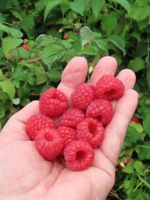Mon-Fri 9am - 5pm Mountain time
Black Elderberry vs Red Mammoth Raspberry
Sambucus canadensis
Rubus sp. SK Red Mammoth
NOT AVAILABLE THIS SEASON - MIGHT RETURN
SOLD OUT
Black Elderberry is a deciduous shrub native to eastern North America. You can plant this shrub in moist areas and it will help stabilize your soil. You can also use it on rural properties anywhere you'd use a lilac.
Black Elderberries are considered to be partially self-pollinating. So while they will still produce some berries without cross-pollination, planting with another variety will increase yields. Consider planting with Ranch Elderberry or Bob Gordon Elderberry.
Warning: the seeds, stems, leaves, roots, and uncooked berries of the Black Elderberry are poisonous to humans when eaten in quantity. You should cook the berries to make them safe for human consumption.
Developed by the University of Saskatchewan Fruit Program, SK. Red Mammoth was a high yielding and firm variety released in 1999. It produces distinctively large bright red berries about 1 inch wide. It is also more cold hardy than older raspberry cultivars. Red Mammoth is firm which makes it suitable for commercial production and sweeter than Boyne. Floricane.
Needs to be trellised as canes are not as sturdy as other varieties.
Black Elderberry Quick Facts
Red Mammoth Raspberry Quick Facts
Toxicity: leaves, stems, and uncooked berries are poisonous to humans

